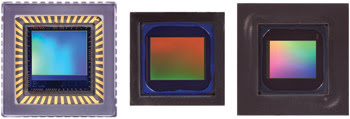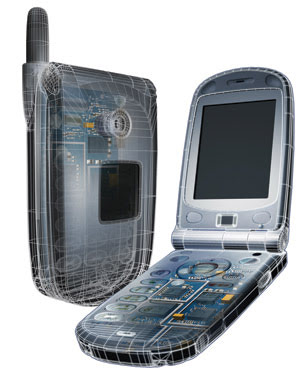Knowing about feature and benefit trade-offs can help camera phone designers achieve an optimum balance.
Vern Klein, Micron Technology Inc.
When choosing an imager for a mobile phone, designers consider cost, size and image quality — usually in that order. Consumers expect strong camera and phone functionality. They look for sleek handset designs and insist on affordable phones. Providers want to deliver all of these things and still turn a profit.

With improvements in imaging technology, vendors can maintain image quality regardless of the application. The top image was taken with a 3-megapixel camera phone. The bottom image was taken with a 5-megapixel image sensor.
Because lowest cost, smallest size and highest quality do not naturally coexist in the world of image sensors, designers have to make compromises. Factors that can help them find the imager that best meets their needs include:
• Fabrication: To keep costs lower and quality higher, fabrication facilities must support high-volume, high-quality image sensor manufacturing.
• The market intent for end products: Retail practices and consumer habits affect the choice of image sensor and cell phone design. Many cell phone providers are either giving away mobile handsets for promotional purposes or pricing them low to obtain high-volume sales.
• The demands of end users: Consumers push phone providers to offer free or inexpensive phones, but they still demand that the phone have a camera that takes relatively crisp pictures.
Imager design costs
To manage costs, designers need to know what factors influence those costs. The size of the module, the fabrication facilities in which imagers are manufactured and the design changes that imagers constantly undergo all have an effect.
The size and cost of a module are linked to the quality and quantity of the components it holds. The more integrated a chip, the more costly it is. However, a fully integrated chip that provides onboard processing saves designers from needing more components elsewhere in the system, thereby lowering the overall cost. Higher integration at the sensor level also produces a better imager in a lower-cost system.
To further realize cost savings, designers seek out companies that are building massive quantities of imagers. Many companies are trying to get into the hot imaging market, but most are unprepared to produce a quality imager. The winners in this market generally run high-volume and high-quality imagers, and transfer volume easily across multiple fabrications to meet mobile phone manufacturing supply demands.
Consumers have spoken: Thin is in. But for most imager manufacturers, a smaller size comes only at the expense of crisp images. Whereas digital single-lens reflex cameras have the luxury of using larger optics and sensors, camera phones don’t. Right now, technological developments are focusing on the physics of these optics and on real-estate placement so that camera sizes can shrink.
Other considerations are pixel, die and module size, and many imaging design companies are working closely with module makers to improve the overall size of the sensor.
Imager quality
Customers expect cameras even in free phones or in those offered cheaply with their phone service. However, every dollar spent on the camera in a giveaway phone cuts into the company’s profits. Phone providers don’t want to include a costly high-quality image sensor in a handset when the camera itself isn’t necessarily the key selling point, but rather a single item on the consumer’s checklist. For more complex phones that are not free, companies have more leeway to invest in the camera without taking a big loss.
On the plus side, higher cost does not translate directly into higher image quality or resolution. Experienced image sensor manufacturers tend to have an efficient chip-fabrication process that improves the quality of the sensors and produces a good yield.
Currently, the production volume for camera phones is quite large, which means that companies are willing to do the research and development to improve their sensors. Those that move large quantities are willing to work out some of the trouble areas for low-cost imagers, such as color reproduction and light sensitivity.
New techniques
Various design and manufacturing techniques should be taken into account when designing image sensors into camera phones, including conversion of light to digital images, pixel architecture and electromagnetic interference testing.
From a pixel architecture standpoint, the pixels can be laid out in many ways to improve the camera. When implementing each process improvement, careful planning is required to best match pixel architecture to achieve top performance. Mobile phone manufacturers can carefully route the signals to decrease the overall physical size of the phone.
Reducing electromagnetic interference seems to be high on everyone’s goal list. Right now, mobile phone makers need to pass stringent tests. Improvements in this endeavor include using a high-speed serial interface instead of running a parallel interface. The movement away from running parallel lines also helps to reduce electromagnetic interference.

While reducing the size of a 1.3-megapixel sensor from 1/2 to 1/4 in., shrinking pixel technology maintains resolution. Although not exactly to scale, the sensor area shows the relative size as it is reduced from 1/2 in. to 1/3 in. and then to 1/4 in.
Another process and technique improvement lies with the image signal processor. The general trend is to reduce size: smaller pixels and smaller devices. Because of the pressure to make everything smaller, designers have become very innovative, using processing techniques to gain back image quality often lost in pixel shrinkage (including color fidelity, contrast and noise).
Future products
As we move forward, it remains critical that camera designers know what consumers want from their devices. At present, they want to capture both stills and videos with a single camera. They want to use software that automatically captures the “best picture taken” when they upload their pictures and video.
Consumers also want cameras with the ability to capture more images per second — cameras thathave a fast autofocus, video that is produced with high-definition quality and devices that handle image stabilization well.
One of the newest designs on the market uses multiple cameras in handsets. One of the cameras has the high resolution required for digital still cameras, and another has low resolution for videoconferencing applications. By using two sensors with different purposes, designers can build phones that are both reliable and cost-effective.

Future cell phones will have videoconferencing and high-definition-quality video capabilities. This image shows a rendering of a camera phone with two image sensors designed into it.
Image sensor and mobile applications designers are being offered more design choices than ever before. Whether the requirement is for an imager solution for an entry-level handset or for digital still camera-quality imaging on a high-end, feature-rich smart phone, designers must understand which imaging device best meets their design and production needs.
Meet the author
Vern Klein is director of marketing at Micron Technology Inc. in San Jose, Calif.; e-mail: [email protected].